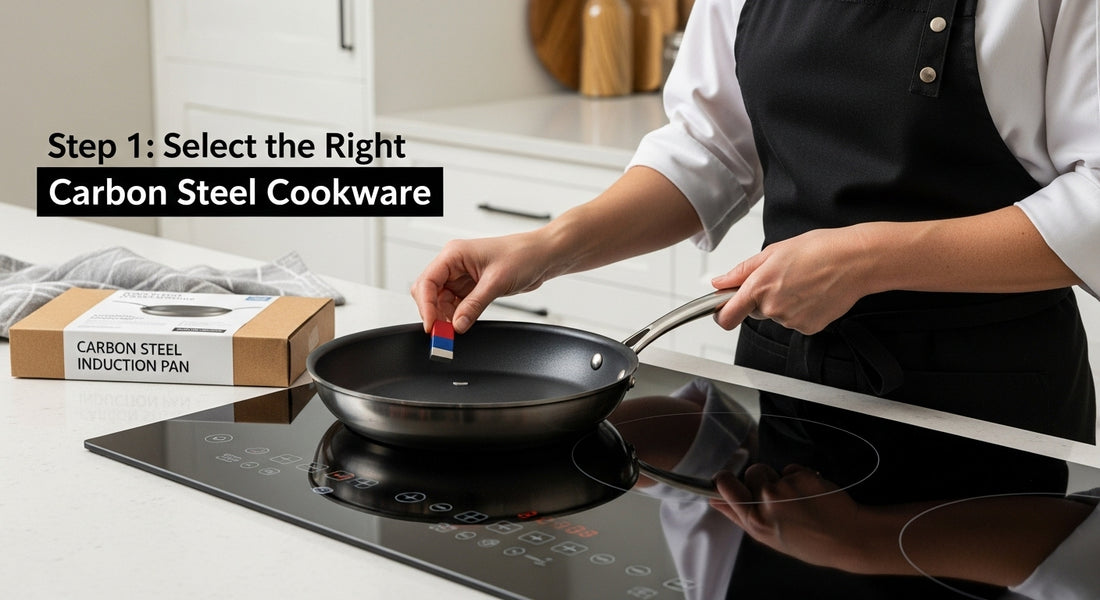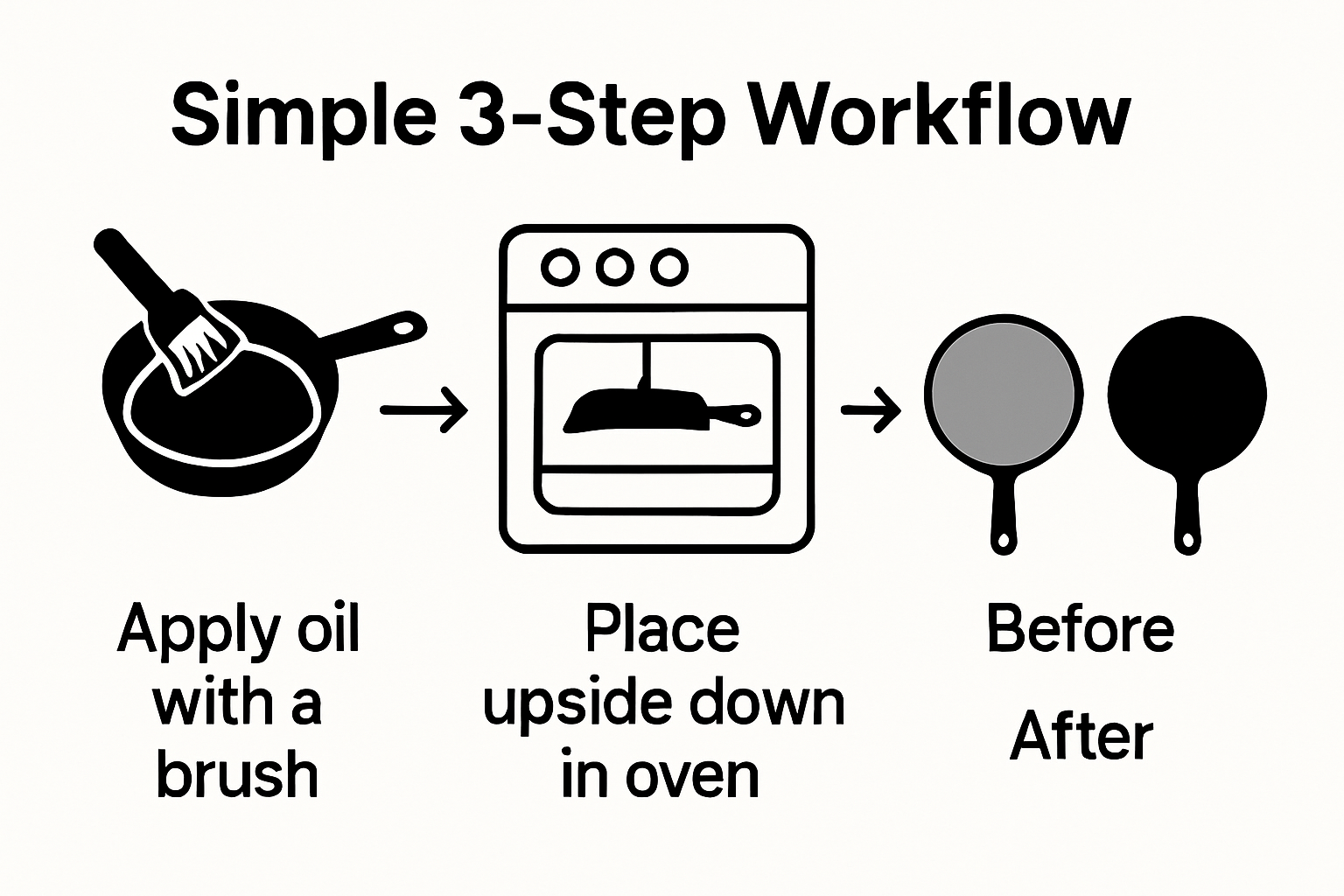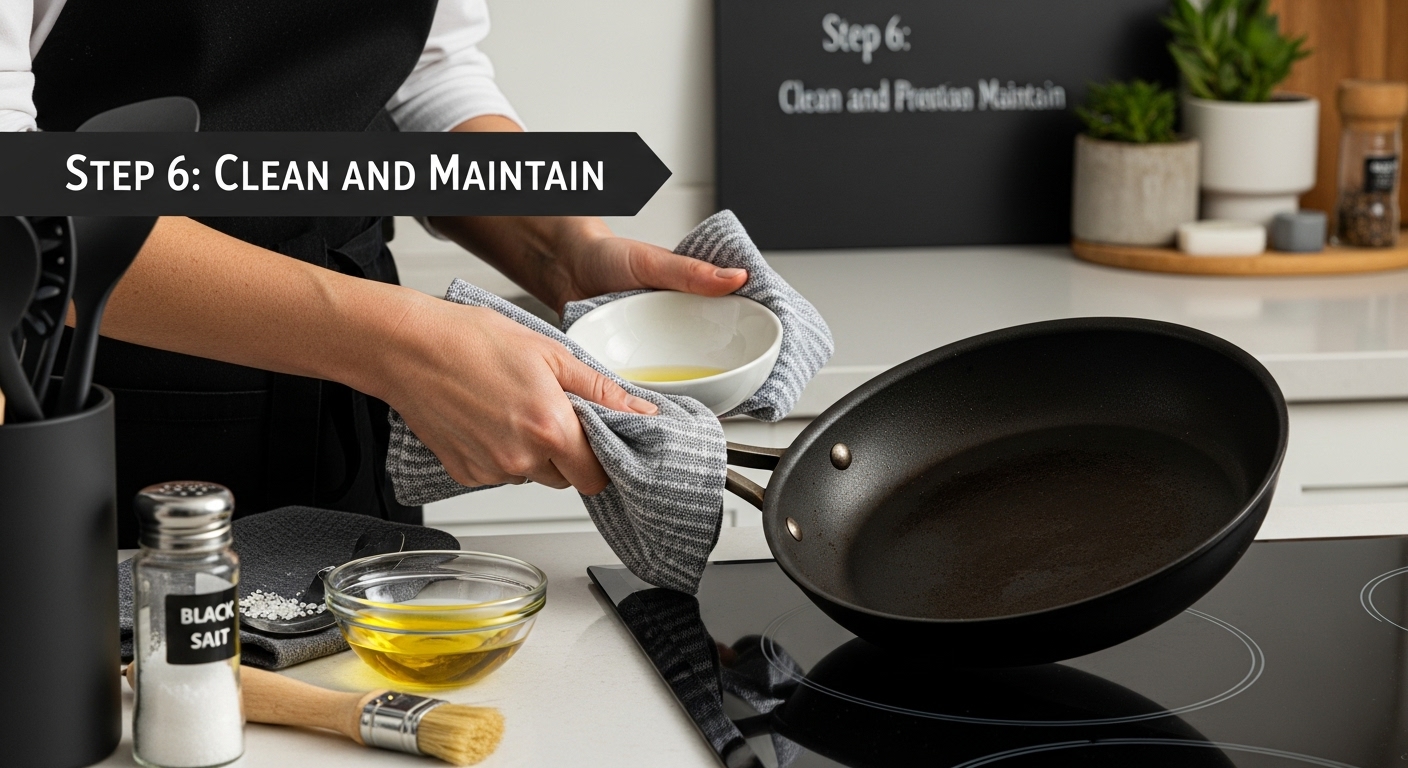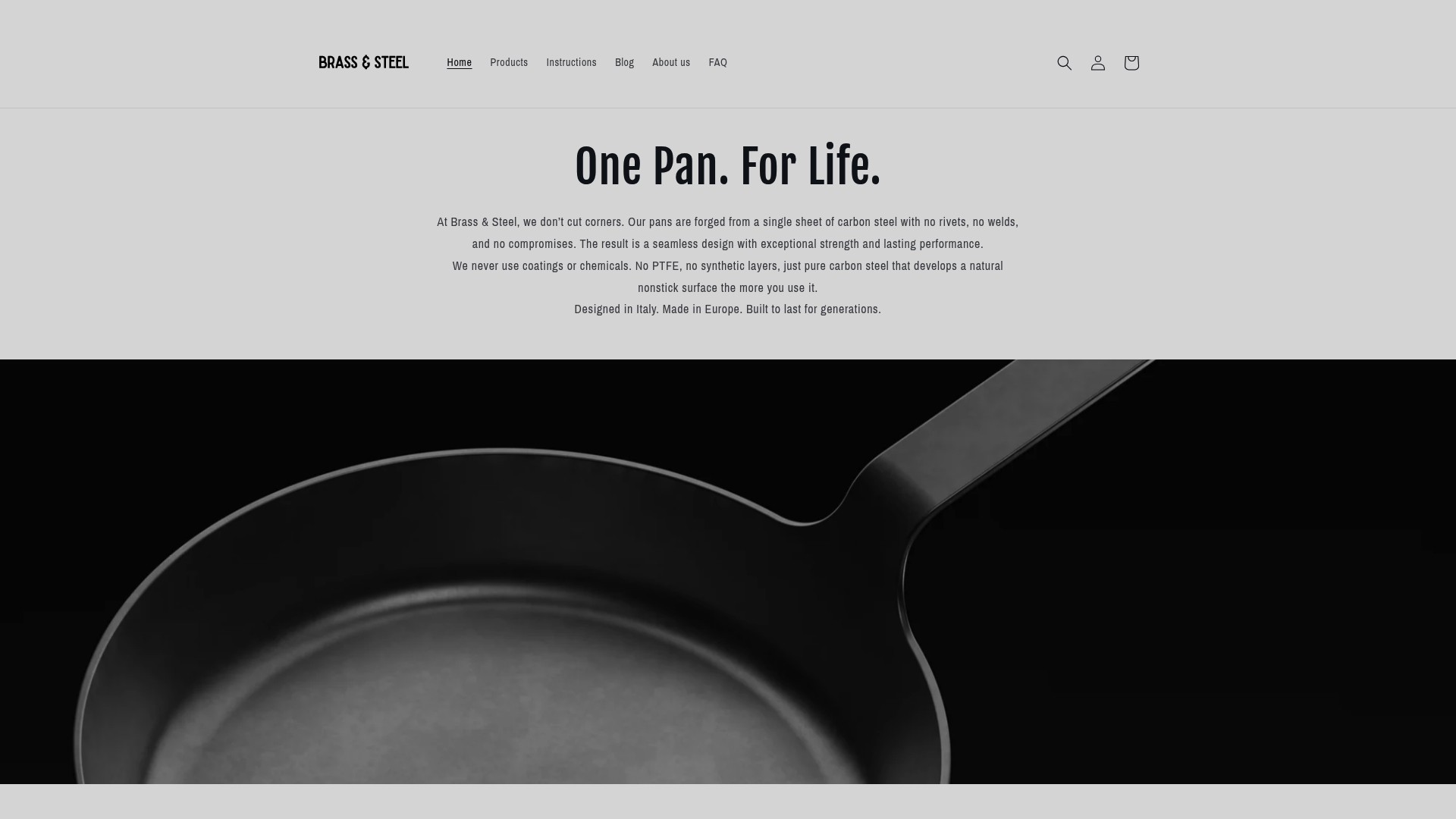
Master Using Carbon Steel on Induction for Perfect Cooking
Share
Cooking with carbon steel on induction hobs is fast becoming a chef’s secret weapon. It is not just durable, but when you use the right technique, carbon steel develops a naturally nonstick surface that gets better the more you cook. But while most people focus on what they cook, few realise the real magic comes from how precisely you match your pan, cooktop and method. That extra bit of care makes all the difference and turns ordinary meals into something truly spectacular.
Table of Contents
- Step 1: Select The Right Carbon Steel Cookware
- Step 2: Prepare Your Induction Cooktop
- Step 3: Season Your Carbon Steel Pan
- Step 4: Preheat The Pan On Induction
- Step 5: Cook Food With Precision
- Step 6: Clean And Maintain Your Carbon Steel Cookware
Quick Summary
| Key Point | Explanation |
|---|---|
| 1. Select 3mm Thick Carbon Steel | Choose cookware that is at least 3mm thick for superior heat retention and induction compatibility. |
| 2. Conduct a Magnet Test | Use a magnet to verify if your pan is induction compatible; a strong adherence indicates compatibility. |
| 3. Properly Season Your Pan | Clean with warm water and apply high smoke point oil to create a nonstick surface that improves with use. |
| 4. Preheat Gradually on Induction | Start at low to medium heat to ensure even warming without damaging the seasoning of the pan. |
| 5. Clean without Soap | After cooking, wash with warm water only; avoid harsh detergents to preserve the seasoning and protect the pan. |
Step 1: Select the Right Carbon Steel Cookware
Choosing the perfect carbon steel cookware for induction cooking requires careful consideration and understanding of your specific culinary needs. The right pan can transform your cooking experience, offering superior heat distribution and a naturally developing nonstick surface that improves with every use. Thickness and construction matter significantly when selecting your carbon steel cookware, especially for induction compatibility.
Induction cooktops demand specific materials that can create a magnetic field, and carbon steel meets these requirements perfectly. When shopping for your ideal pan, look for cookware with a minimum thickness of 3mm, which ensures excellent heat retention and prevents warping. Professional chefs recommend selecting pans forged from a single piece of steel, as these eliminate potential weak points like rivets or welded seams. Learn more about selecting the right carbon steel pan to understand the nuanced considerations beyond basic functionality.
Key factors to evaluate include pan weight, handle design, and intended cooking applications. Lighter pans around 2kg work well for everyday home cooking, while heavier options near 3kg provide enhanced performance for professional kitchen environments. Consider your typical cooking style: do you frequently sear meats, sauté vegetables, or prepare delicate sauces? These questions will guide your selection process. For induction compatibility, ensure the pan has a completely flat bottom that can make full contact with the cooktop surface, maximizing heat transfer efficiency and preventing energy waste.
Verifying induction compatibility is straightforward. A simple magnet test can confirm whether your carbon steel cookware will work effectively: if a magnet strongly adheres to the bottom of the pan, it will function perfectly on an induction stovetop. When purchasing, look for clear manufacturer specifications indicating 100% induction compatibility and recommended power settings to protect both your cookware and cooking surface.
Below is a summary table outlining the essential tools and materials needed for mastering carbon steel cooking on induction, including their purposes and specific recommendations.
| Tool/Material | Specification/Recommendation | Purpose |
|---|---|---|
| Carbon Steel Pan | Minimum 3mm thick, flat bottom, 2-3kg weight | Induction compatibility, even heat, and durability |
| Magnet | Strong adherence test | Verify pan induction compatibility |
| High Smoke Point Oil | Grapeseed, sunflower, or avocado oil | Seasoning and maintenance of nonstick surface |
| Microfibre Cloth | Non-abrasive | Cleaning induction cooktop and pan |
| Ceramic Cooktop Cleaner | Specialised for induction surfaces | Ensures pristine cooktop, avoids scratches |
| Oven | Preheated to 250°C (480°F) | For initial seasoning and building protective layer |
| Kosher Salt | Used as scrubbing agent | Removes tough food residue without damaging seasoning |
| Soft Sponge/Cloth | Non-abrasive | Gently cleans pan without stripping seasoning |
Step 2: Prepare Your Induction Cooktop
Preparing your induction cooktop for carbon steel cookware requires precision and understanding of how these advanced cooking surfaces operate. Temperature control and surface preparation are critical to achieving optimal cooking results and protecting both your cookware and cooking surface. Induction technology operates differently from traditional gas or electric stovetops, demanding specific handling techniques that enhance performance and longevity.
Learn more about induction cooktop compatibility to understand the nuanced interactions between your cookware and cooking surface. Begin by thoroughly cleaning your induction cooktop, removing any dust, grease, or residue that might interfere with heat transfer. Use a soft microfibre cloth and a specialized ceramic cooktop cleaner to ensure a pristine surface. Avoid abrasive materials that could scratch the delicate glass surface, which could compromise the cooktop’s magnetic conductivity and heat distribution capabilities.
Before placing your carbon steel pan, verify that the cooktop surface is completely dry and the pan’s bottom is clean and flat. Induction cooktops require direct, complete contact for efficient heat transfer. Small imperfections or debris can create uneven heating and potential hot spots that might damage your cookware. Professional chefs recommend starting with lower heat settings and gradually increasing temperature, allowing your carbon steel pan to heat evenly and preventing potential warping. Moderate power settings between 4-6 are ideal for most cooking techniques, providing consistent heat without overwhelming the pan or cooktop.
Verify your setup by observing how quickly and evenly the pan heats. A properly prepared induction cooktop will create an immediate, uniform heat response in your carbon steel cookware. Listen for any unusual sounds and watch for consistent heat distribution across the pan’s surface. If you notice any uneven heating or strange noises, adjust your pan’s position or reduce the power setting to ensure safe and effective cooking.
Step 3: Season Your Carbon Steel Pan
Seasoning your carbon steel pan is a crucial process that transforms a raw cooking surface into a naturally nonstick, rust-resistant culinary tool. This step creates a protective layer that not only enhances your pan’s performance but also develops a unique patina that improves with each cooking session. Discover the complete guide to seasoning carbon steel for professional insights into this essential technique.
Begin by thoroughly washing your new carbon steel pan with warm water and a soft sponge, removing any protective manufacturing coating. Dry the pan completely using a clean kitchen towel or paper towels, ensuring no moisture remains. Select a high smoke point oil like grapeseed, sunflower, or avocado oil. These oils create a more durable seasoning compared to olive or vegetable oils. Apply a thin, even layer of oil across the entire pan surface, including the exterior and handle. Use a clean cloth or paper towel to spread the oil, removing excess until the pan looks almost dry. Excess oil will create a sticky, uneven surface.
Preheat your oven to 250°C (480°F) and place the pan upside down on the middle rack. This positioning allows any remaining oil to drip away, preventing pooling and ensuring an even seasoning. Bake the pan for approximately 30 minutes, which allows the oil to polymerize and bond with the steel, creating a hard, protective coating. After the initial session, let the pan cool completely in the oven. Repeat this process two to three times for a robust initial seasoning. You will know the seasoning is successful when the pan develops a dark, smooth, and slightly glossy appearance.
 A well-seasoned pan will have a uniform dark brown or black color, indicating a strong protective layer that prevents rust and provides natural nonstick properties. Future cooking with fatty foods will continue to improve and strengthen this seasoning, creating a cooking surface that becomes more effective with each use.
A well-seasoned pan will have a uniform dark brown or black color, indicating a strong protective layer that prevents rust and provides natural nonstick properties. Future cooking with fatty foods will continue to improve and strengthen this seasoning, creating a cooking surface that becomes more effective with each use.
Step 4: Preheat the Pan on Induction
Preheating your carbon steel pan on an induction cooktop requires precision and understanding of heat distribution principles. Proper preheating ensures even cooking and prevents food from sticking, creating a professional cooking experience that mimics restaurant-grade techniques. Learn more about advanced carbon steel cooking techniques to elevate your culinary skills.
Start by placing your seasoned carbon steel pan on the induction cooktop, ensuring the entire bottom surface makes complete contact with the cooking zone. Begin with a low to medium heat setting, typically between power levels 3 to 5, which allows the pan to warm gradually and evenly. Carbon steel conducts heat differently from other materials, requiring a more measured approach. Unlike cast iron, which retains heat intensely, carbon steel responds quickly to temperature changes, making controlled preheating essential. Watch for subtle color changes in the pan surface as it heats, which indicates the metal is reaching an optimal cooking temperature.
To verify proper preheating, perform a simple water droplet test. Sprinkle a few drops of water onto the pan surface after 2-3 minutes of heating. Perfectly preheated carbon steel will cause the water to dance and skitter across the surface in small beads, creating a mesmerizing effect known as the Leidenfrost phenomenon. If the water immediately evaporates or sits stationary, your pan needs more time to reach the correct temperature. Professional chefs recommend a preheating duration of 2-4 minutes, depending on your specific induction cooktop and pan thickness. Avoid overheating by keeping the temperature moderate, which prevents potential damage to your pan’s seasoning and ensures consistent cooking performance. Remember that each carbon steel pan develops its unique heat signature over time, so practice and observation are key to mastering this essential cooking technique.
Step 5: Cook Food with Precision
Cooking with carbon steel on an induction cooktop demands a nuanced approach that balances technique, temperature control, and understanding of your cookware’s unique characteristics. Precision is the cornerstone of exceptional cooking, transforming simple ingredients into restaurant-quality meals. Explore professional kitchen cookware techniques to elevate your culinary skills and understand the subtleties of advanced cooking methods.
Begin by adding a small amount of high smoke point oil to your preheated pan, ensuring an even, thin layer that prevents sticking while promoting beautiful caramelization. Temperature management is critical: keep your induction cooktop setting between medium and medium-high, typically around power levels 5-7. Carbon steel’s remarkable heat conductivity means you can achieve restaurant-style searing with less energy and more control. When cooking proteins like steak or chicken, resist the temptation to move the food immediately. Allow meats to develop a golden-brown crust by letting them sit undisturbed for 2-3 minutes, which creates those coveted caramelized edges that signify professional cooking technique.
To verify your cooking precision, observe visual and auditory cues that indicate optimal heat and technique. A perfectly seared piece of meat will release easily from the pan without tearing, signaling that the Maillard reaction is complete. Listen for a consistent, gentle sizzle that indicates stable heat distribution. Pay attention to the pan’s color changes the first few times you cook, as these provide valuable feedback about your technique. The pan’s developing patina will darken with each cooking session, creating a naturally nonstick surface that improves with use. Remember that carbon steel on induction is a dynamic cooking system requiring your active engagement and subtle adjustments, transforming cooking from a mere task into a responsive, interactive culinary experience.
Step 6: Clean and Maintain Your Carbon Steel Cookware
Caring for your carbon steel cookware is an art that directly impacts its performance, longevity, and cooking quality. Proper maintenance transforms your pan from a simple kitchen tool into a lifetime culinary companion. Explore comprehensive carbon steel maintenance techniques to preserve your cookware’s exceptional characteristics.
Immediately after cooking, clean your pan while it is still warm but not scalding hot. Avoid using soap or harsh detergents, which can strip away the carefully developed seasoning. Instead, use warm water and a soft sponge or cloth to remove food residue. For stubborn stuck-on bits, use kosher salt as a gentle abrasive scrubbing agent, creating a natural scrubbing paste that removes debris without damaging the pan’s surface. Rinse thoroughly and dry immediately with a clean kitchen towel to prevent rust formation.
After cleaning, apply a thin layer of high smoke point oil to maintain the pan’s seasoning and protective coating. Rotate the pan to ensure even coverage, using a clean cloth to remove excess oil until the surface looks almost dry. Store your carbon steel cookware in a cool, dry place with good air circulation. Avoid stacking other cookware directly on top of your pan, which could damage the seasoning. Periodically inspect the pan’s surface for any signs of rust or uneven seasoning. If you notice a dull or sticky patch, it is time to perform a quick re-seasoning. By dedicating a few minutes to careful maintenance after each use, you will ensure your carbon steel pan remains a reliable, high-performance cooking instrument that improves with every meal you prepare.
Here is a troubleshooting table that addresses common problems encountered when using carbon steel on induction, along with potential causes and practical solutions from the article.
| Problem | Possible Cause | Solution |
|---|---|---|
| Pan warping | Heating too quickly on high power | Preheat gradually on low-medium setting and increase slowly |
| Food sticking | Insufficient seasoning or improper preheating | Ensure pan is well-seasoned and properly preheated (water test) |
| Uneven heating | Dirty cooktop/pan or uneven contact | Clean both surfaces and ensure full flat contact with cooktop |
| Seasoning sticky or patchy | Excess oil during seasoning | Apply thin oil layer, wipe thoroughly before oven seasoning |
| Rust formation after washing | Pan not dried or oiled post-cleaning | Dry immediately and apply thin layer of high smoke point oil |
| Scratched induction surface | Abrasive cleaning materials used | Only use microfibre cloth and ceramic cooktop cleaner |

Unlock Professional Results with Brass & Steel Carbon Steel on Induction
You have just learned how mastering carbon steel pans on induction cooktops creates precision, flavour, and consistency. But are you still searching for the right pan that truly brings out the best in your kitchen? Many home cooks struggle with uneven heating, warping, and sticky surfaces from mass-produced pans. The Carbon Steel Collection | Brass&Steel offers a solution engineered for your induction adventures. Each pan is crafted from one flawless piece of carbon steel, which means you benefit from unmatched durability, natural nonstick performance, and perfect heat transfer every time you cook.

Step up to a new calibre of cooking. Choose between our 27 cm or 30 cm carbon steel sauté pans, trusted by professionals and home chefs for everyday versatility or serious family feasts. Discover the advantages of seamless design and health-safe, PTFE-free surfaces. It is time to experience the difference yourself. Explore the full range and secure your ideal pan at https://brass-steel.com. Perfect your induction technique with the tools you deserve—visit our Carbon Steel Collection now and taste the results in your very next meal.
Frequently Asked Questions
How do I choose the right carbon steel cookware for induction?
Choosing the right carbon steel cookware for induction involves considering thickness, construction, and intended use. Look for pans with a minimum thickness of 3mm and a completely flat bottom for optimal heat transfer and compatibility with induction cooktops.
What is the best way to season my carbon steel pan?
To season your carbon steel pan, wash it with warm water, dry it thoroughly, apply a thin layer of high smoke point oil, and bake it upside down in the oven at 250°C (480°F) for about 30 minutes. Repeat this process 2-3 times for a strong seasoning.
How should I preheat my carbon steel pan on induction?
Preheat your carbon steel pan on an induction cooktop by placing it on low to medium heat (levels 3-5). Allow it to warm gradually for 2-4 minutes, and verify the temperature using a water droplet test: water beads should dance across the surface if the pan is correctly preheated.
What maintenance is required for carbon steel cookware?
To maintain your carbon steel cookware, clean it with warm water and a soft sponge after use. Avoid soap, dry it immediately, and apply a thin layer of high smoke point oil to preserve the seasoning. Store it in a cool, dry place, and inspect occasionally for rust or uneven seasoning.
Recommended
- Cooking with Carbon Steel Step by Step: Mastering Techniques – Brass & Steel
- How to Use Carbon Steel Pans on Induction Cooktops (Compatibility & Ti – Brass & Steel
- Understanding Iron vs Carbon Steel for Culinary Use – Brass & Steel
- How to Cook Steak in a Carbon Steel Pan: Perfect Every Time – Brass & Steel